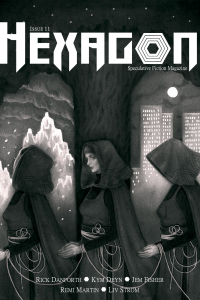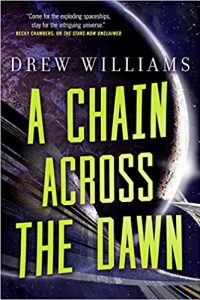Gary K. Wolfe Reviews Uncommon Miracles by Julie C. Day
 Uncommon Miracles, Julie C. Day (PS 978-1-786363-34-3, £20.00, 234pp, hc) October 2018.
Uncommon Miracles, Julie C. Day (PS 978-1-786363-34-3, £20.00, 234pp, hc) October 2018.
Well, aren’t we about overdue for the bunny apocalypse? That seems to be the question Julie C. Day raises in “Everyone Gets a Happy Ending”, the lead story in her first collection Uncommon Miracles, and it’s not quite as whimsical as it sounds. It follows the familiar pattern of end-of-days tales, with two friends making their way from Ohio to a rumored sanctuary in Arizona, through a devastated America overrun with bunnies, many born to human mothers through some sort of parthenogenesis (even the narrator’s friend Steph is pregnant with a litter). There’s not a shred of rationale for why this is happening, other than Sister Francis, the leader of the sanctuary, suggesting that “All these bunnies are guiding a vast new web of life across the land. Unlike the Flood, I just don’t think God wants us to be a part of it anymore.” It’s hard to describe any one of the 18 stories collected here as characteristic of Day’s approach to fiction, since she demonstrates such an impressive range of tones and topics, but we can see here what will become a few recurring elements: a fascination with American landscapes as psychic spaces (with occasional side trips to Paris or the Azores), an almost playful manipulation of genres tropes and protocols, a fondness for subtitles that segment tales into discreet scenes, a resolute focus on characters haunted by memory and sometimes by grief, and an almost casual disinterest in linear plotting.
In one of the most moving stories, “The Woman in the Woods”, a pair of orphaned children whose father has died of cholera in a turn-of-the-century New York tenement find themselves on another westward journey, on one of the orphan trains that actually relocated thousands of poor children over many decades a century ago, until a train crash strands them in the Iowa woods, where the elusive title figure reminds them of their missing mother. “Florida Miracles”, featuring another missing mom, takes place in a decaying Titusville FL, long after the space program faded, and features a narrator who believes she is inhabited by an 8,000-year-old “Masker,” while she tries to protect a troubled teen given to self-mutilation. The graphic conclusion has a lot to say about real and imaginary dragons. An isolated island in Maine is the setting of “Signal and Stone”, in which a teen girl finds that the lack of cell reception frees her from the “Ghost Boy” who had been stalking her back on the mainland – but where she confronts a different kind of ghosts. A small town in Massachusetts provides the setting for “I Want to Be Here”, whose grief-driven narrator is convinced by a stranger that his recurring auto crashes are a mechanism for a form of time travel.
Time travel isn’t the only SF device that Day deploys – she’s trained as a microbiologist – but such devices are seldom foregrounded. “One Thousand Paper Cranes”, one of the few stories to be set largely in a clearly defined future, involves treatment of “societal ills and personal pain” through something called “chemically-regulated, restricted-environmental-stimulation therapy,” in which a couple of weeks of treatment will seem like years to the subject (somewhat as in Kelley Eskridge’s Solitaire, perhaps). A family of women in the Azores not only seem to have achieved a method of reproducing asexually, but can travel between parallel timelines or “branes.” An obsessive hoarder about to be evicted from public housing in Arizona compares his accumulation of debris to his scientist family’s observations of Bok globules, the small nebulae that may be cradles of star formation. Occasionally, though, Day moves fully into a kind of horror-tinged fantasy, as with the unicorn slaughterhouse that is the central image in “The Re’em Song” or the Angela Carter-like take on Red Riding Hood, “Raven Hair”. Sometimes Day seems so fascinated with the fecundity of her own invention that it impedes the forward movement of her narratives, but the range of that invention, and her capacity for engaging bizarre ideas in the exploration of deeply felt and deeply damaged characters, can be stunning.
Gary K. Wolfe is Emeritus Professor of Humanities at Roosevelt University and a reviewer for Locus magazine since 1991. His reviews have been collected in Soundings (BSFA Award 2006; Hugo nominee), Bearings (Hugo nominee 2011), and Sightings (2011), and his Evaporating Genres: Essays on Fantastic Literature (Wesleyan) received the Locus Award in 2012. Earlier books include The Known and the Unknown: The Iconography of Science Fiction (Eaton Award, 1981), Harlan Ellison: The Edge of Forever (with Ellen Weil, 2002), and David Lindsay (1982). For the Library of America, he edited American Science Fiction: Nine Classic Novels of the 1950s in 2012, with a similar set for the 1960s forthcoming. He has received the Pilgrim Award from the Science Fiction Research Association, the Distinguished Scholarship Award from the International Association for the Fantastic in the Arts, and a Special World Fantasy Award for criticism. His 24-lecture series How Great Science Fiction Works appeared from The Great Courses in 2016. He has received six Hugo nominations, two for his reviews collections and four for The Coode Street Podcast, which he has co-hosted with Jonathan Strahan for more than 300 episodes. He lives in Chicago.
This review and more like it in the January 2019 issue of Locus.
 While you are here, please take a moment to support Locus with a one-time or recurring donation. We rely on reader donations to keep the magazine and site going, and would like to keep the site paywall free, but WE NEED YOUR FINANCIAL SUPPORT to continue quality coverage of the science fiction and fantasy field.
While you are here, please take a moment to support Locus with a one-time or recurring donation. We rely on reader donations to keep the magazine and site going, and would like to keep the site paywall free, but WE NEED YOUR FINANCIAL SUPPORT to continue quality coverage of the science fiction and fantasy field.







